The Impact of High-Density Urban Wind Environments on the Distribution of COVID-19 Based on Machine Learning: A Case Study of Macau
Abstract
:1. Introduction
1.1. Research Background
1.2. Literature Review
1.2.1. The Pandemic and the Urban Wind Environment
1.2.2. Application Areas of Machine Learning in COVID-19
1.2.3. COVID-19 and Housing Conditions
1.3. Problem Statement and Objectives
- (1)
- Taking Macau, China, as an example, what is the impact of the high-density urban space and the urban wind environment it shapes on the distribution of COVID-19?
- (2)
- How does machine learning technology assist in analyzing the distribution of COVID-19?
- (3)
- Further, based on the footprint data of 500 cases of the outbreak in Macau, China, in June 2022, what is the correlation between COVID-19 and the urban wind environment?
- (4)
- How do urban wind environments promote or inhibit the distribution of COVID-19 under different morphological layouts?
- (5)
- Using the layout planning and design of sustainable residential areas, which type of form is more conducive to adapting to the environment of pandemic diseases?
- (6)
- In the post-pandemic era, what reflections can this research provide for other similar epidemics?
2. Materials and Methods
2.1. Data Collection
- (1)
- Building performance simulation: Ecotect can simulate the performance of buildings under different wind conditions. With the software, researchers can accurately assess the impact of different wind environments on the spread of COVID-19 and gain insight into the relationship between the built environment and virus spread.
- (2)
- Data collection and analysis: Ecotect provides a wealth of data collection tools to obtain the environmental parameters required by the building, such as wind speed, wind direction, and indoor and outdoor temperatures. These data are crucial for studying the association of urban wind environments with the spread of COVID-19.
- (3)
- Result visualization: Ecotect provides an intuitive result visualization function. Through charts and images, researchers can clearly display and present the analysis results. These visualization tools are important to convey research findings and conclusions to judges and readers and contribute to a better understanding of the link between urban wind environments and the spread of COVID-19.
2.2. Data Processing
2.3. CGAN Method
3. Model Training
3.1. Model Training Process and Verification
- (1)
- In the early stages of training, Model 1 and Model 2 rapidly reduce the loss value, showing a preliminary understanding and grasp of the characteristics of the data. As the training progresses, they gradually optimize the parameters and network structure, and their ability to adapt to the data distribution continues to improve. This leads to a continuous decrease in the loss value, which reaches a lower level at a certain stage. With the deepening of training, the loss value gradually tends to be stable, indicating that the model has learned the key features of the data and reached an equilibrium state during the optimization process. The model has reached a good level of performance, and further training may not improve performance significantly. Therefore, the model goes through an initial stage of learning and progressive optimization, and finally it reaches a state where learning converges.
- (2)
- In the training log of statistical CGAN, it is observed that the minimum values of different indicators appear at different iteration numbers. This shows that the optimization process of the model has achieved a balance among various indicators, and the performance of each indicator is considered comprehensively rather than paying too much attention to a specific indicator. At the same time, the minimum values of different indicators are distributed on different iteration numbers, which may indicate mutual influence and interaction between them. The optimization of the model requires trade-offs and adjustments between various indicators to achieve a balanced and optimal training result. In addition, the minimum values of different indicators appear at different iteration numbers, which may also mean that the model gradually optimizes different aspects at different stages. A model may first focus on the optimization of a certain metric and then gradually shift to the optimization of other metrics to achieve better overall performance. These observations thus reveal important features such as balanced optimization, inter-metric interactions, and stepwise optimization during model training.
- (3)
- The lower Mean G_GAN, Mean D_fake, and Mean D_real indicate that the adversarial training between the generator (G) and the discriminator (D) has reached a balanced state. The generator can successfully fool the discriminator into generating realistic samples. At the same time, the discriminator can effectively distinguish generated samples from real samples and give accurate discriminative results. This shows that the model has stability, and the generator has effectively learned the characteristics of the data distribution during the training process and can generate high-quality samples similar to real samples. The discriminator has a high discrimination ability and can accurately judge the authenticity of the generated samples. Therefore, these observations reflect the model’s stability, efficient generative ability, and high-quality discriminative ability.
3.2. Correlation Analysis of the Wind Environment and COVID-19 in Different Building Layout Types
3.3. Robustness Test of the Model
- (1)
- In Figure 12 group number 1,2, the difference percentages are small (26.81% and 22.76%). This is because the two illustrations have a clear separation of building groups and public spaces, as well as higher wind speeds, factors that allow the model to generate a more accurate map of the distribution of COVID-19 hotspots.
- (2)
- In Figure 12 group number 3,4, the difference percentages are higher (56.70% and 49.47%). The reason for this is that some of these buildings are not residential or have been out of use, in which case the model cannot distinguish well, resulting in generated COVID-19 hotspot distribution results that deviate significantly from the actual situation. In addition, the model avoids the generation of COVID-19 hotspots in the position of wind flow so that the overall generation results still have a certain degree of accuracy.
- (1)
- Figure 13 group number 1 features the smallest error value among the other pictures (75.83%). This is because the input COVID-19 heat map has only a small number of hotspot distributions, and the hotspot density is low. The model considers these areas to be connected to the mountain landscape, so relatively accurate results are obtained, which shows that there is a high correlation between the distribution of COVID-19 and the mountain landscape.
- (2)
- In Figure 13 group number 2, the results generated by the model show that strong wind flow is located in the middle of the building complex. This is because there is no COVID-19 hotspot distribution in the middle of Figure 13 group number 2, and the model believes this area should have good ventilation. The results of this generation are consistent with the actual situation, showing that a better ventilation environment helps to suppress the spread of COVID-19.
- (3)
- The generated results in Figure 13 group number 3 are completely different from the actual situation, and the error percentage is the highest (87.83%). This is because this location is the main commercial area of Macau’s outlying islands, and the spread of COVID-19 is mainly caused by contact between people in commercial activities, such as people smoking in this area, and COVID-19 spreads through smog. This particular case was not anticipated by the model and thus generated completely inaccurate results.
- (4)
- The generated result of Figure 12 group number 4 is similar to that of Figure 13 group number 2. Likewise, in areas where there is no distribution of COVID-19, the model considers them to be better ventilated. Therefore, there is a clear boundary between the building and the wind environment in the generated results.
4. Discussion: Residential Planning under Long COVID-19
4.1. Typical Residential Building Types in Low-Epidemic-Risk Areas
- (1)
- High-density residential buildings without mountains: the building density is relatively high, and there is no obvious mountainous terrain around (the surrounding wind speed is 0.00~6.79 m/s). Its characteristics are: the form of a single residential building presents a “C” shape. Among them, the building is a semi-enclosed “C”-shaped building, and the inwardly enclosed frontal inner part of the building faces the east or south side (windward side) (Figure 16).
- (2)
- High-density residential buildings with mountainous types: The surrounding mountainous terrain has a relatively high building density (the surrounding wind speed is 0.97~8.73 m/s). Residential buildings are built at the foot of the mountain or on top of the mountainous terrain. Its characteristics are that most of the buildings are located on the southeast side of the mountain, and the building form is “strip” or “rectangular”. Further research found that the east and south sides of the mountain are the main windward sides, and residential buildings on the southeast side of the mountain are better ventilated and less affected by the epidemic. The buildings on the west side of the mountain have poor ventilation, and the airflow is blocked by the mountain, which means the buildings are greatly affected by the epidemic. Therefore, residential buildings should be avoided on the west side of the mountain. The single building built at the foot of the mountain has a “strip” shape, with its back against the mountain and its long side facing the southeast, maximizing the windward area. Most buildings built on the mountain are “rectangular”, and the southeast side is less affected by the epidemic (Figure 17).
- (3)
- Low-density residential buildings without mountains: the building density is relatively low, and there is no mountainous terrain around (the surrounding wind speed is 0.00~5.82 m/s). Its characteristics are that the residential building presents a single shape, mostly an “L” or “+”. Among them, the short side of the high-density strip, or “L”-shaped building unit, is the windward side, and the long side faces the northeast or southwest side. The “+”-shaped building layout faces the southeast side, and the “+” is also rotated by 45° to increase the windward area (Figure 18).
- (4)
- Low-density residential buildings with mountainous types: with mountainous terrain all around, the building density is relatively low (the surrounding wind speed is 0.00~4.85 m/s). Its characteristics are that most of the buildings are located on the northwest side of the mountain. The residential buildings at the foot of the mountain are more affected by the wind in the northwest, so the epidemic’s impact is lessened. The single residential building on the northwest side at the foot of the mountain presents a “C” shape, or “rectangle”. Among them, the building is a semi-enclosed “C”-shaped building, and the inwardly enclosed frontal inner part faces the southeast (windward side) or northeast side. The single building located on the northwest side of the mountain is mainly “rectangular”, with its back against the mountain and its long side facing the southeast side (windward side). Compared with buildings located on the northwest side of the mountain, they are more susceptible to the impact of the epidemic. It is recommended that residential buildings be built on the southeast side of the mountain (Figure 19).
- (1)
- “C”-type, high-density residential buildings without mountains (wind speed 2.91~6.79 m/s);
- (2)
- “L” type or “+” type, low-density residential buildings without mountains (wind speed 2.91~5.82 m/s);
- (3)
- “Strip”-type, high-density residential buildings, mostly located on the northeast side of the mountain (wind speed 2.91~8.73 m/s).
- (4)
- “Rectangular”-type high-density residential buildings with mountains, mostly located on the southeast side of the mountain (wind speed 2.91~8.73 m/s).
- (5)
- “C”-type, low-density residential buildings with mountains, mostly located at the foot of the mountain in the northwest (wind speed 2.91~4.85 m/s).
- (6)
- “Rectangular”-type, low-density residential buildings with mountains, mostly located at the foot of the mountain and on the northwest side (wind speed 2.91~4.85 m/s).
4.2. Wind Environment Simulation and Epidemic Situation Analysis and Verification
4.3. Design Principles
- (1)
- Select a site with mountains surrounding it for the residential buildings. Mountain scenery can effectively suppress the epidemic. The northeast side of the mountain is the best place to put a building, followed by the southeast and northwest sides. Keep a certain distance between the building and the mountain to increase the air flow between the building and the mountain.
- (2)
- Residential building form: adopt a “strip” or “rectangular shape”, and use the long side of the building as the windward side as much as possible. Guide the wind into the building to the greatest extent and renew the air in the residential building. The six typical architectural forms summarized above can be used as planning references.
- (3)
- Residential building orientation: Orient the long side of the building towards the southeast side (windward side). Most of the six typical residential buildings summarized above are inclined towards the southeast, and the purpose is to increase the airflow on the windy side as much as possible.
- (4)
- Surrounding wind speed control: It is recommended that the overall wind speed around the building be above 2.91 m/s. The wind speed can be controlled by referring to the wind speed values corresponding to the six typical residential building types obtained in the experiments in this paper. The best wind speed is between 4.85 and 8.73 m/s.
5. Conclusions
- (1)
- There are significant differences in the correlation between different types of wind environments and COVID-19. Areas with high building density are more prone to COVID-19 hotspots. Modern building complexes have better evacuation and public space layouts, which can reduce the concentration of hotspots. In addition, open spaces with high wind speeds can effectively suppress the spread of COVID-19.
- (2)
- The distribution of COVID-19 hotspots in the building complex relates to the characteristics of the building itself. The size of the building area determines the spread of COVID-19. In contrast, the lower COVID-19 distribution in natural mountain landscapes may be aided by the outdoor environment, such as better ventilation conditions and the inhibitory effect of plants.
- (3)
- The model (Model 1) that generates the distribution of COVID-19 hotspots from wind environment data performs well in generating the distribution of COVID-19 hotspots, especially when there is a clear separation between building groups and public spaces, and the wind speed is high. However, in non-residential buildings or areas that have been discontinued, the model’s accuracy drops, requiring further optimization and improvement.
- (4)
- The model (Model 2) that generates wind environment data through the distribution of COVID-19 hotspots is less accurate in generating building and wind patterns but can still show some accuracy in specific cases. This emphasizes the importance of considering the type of input material on the quality of model generation, and the robustness of Model 2 needs to be further improved for complex generation tasks.
- (5)
- For high-density cities such as Macau, in response to long COVID-19 or residential area planning in the post-epidemic era, three principles can be considered: building houses on the northeast side of the mountain; ensuring residential building layouts are of “strip” or “rectangular” design; and orienting the long side of the building towards the southeast (windward side). At the same time, it is recommended that the overall wind speed around the building be above 2.91 m/s, and the best wind speed is between 4.85 and 8.73 m/s.
- (6)
- There is a close relationship between the urban wind environment and the spread of COVID-19, and the specific form of the urban wind environment may have a significant impact on the speed and scope of virus transmission. Therefore, urban planning and public health departments must consider urban wind environments in epidemic prevention and control strategies.
- (1)
- This study only takes Macau as an example, and the research results may be affected by geographical specificity. Therefore, similar studies need to be carried out in more areas (such as low-density cities) to verify the generalizability of the results.
- (2)
- This study only focuses on the impact of urban wind environments on the spread of COVID-19 without considering the combined effects of other environmental factors. Future research can continue to explore the comprehensive impact of different environmental factors (such as light and thermal environments) on the spread of the epidemic.
- (3)
- The design principles and guidelines proposed in this study are based on the exploration of the relationship between the urban wind environment and the spread of COVID-19. This provides new perspectives for urban planning and public health authorities to develop strategies to help reduce the risk of spreading the disease. However, design principles belong to the stage of theoretical exploration. This may limit its direct application in practice. The impact and needs of other diseases should be considered in implementing subsequent design principles to respond to the ever-changing urban environment. At the same time, builders should actively cooperate with professionals in related fields, such as urban planners, architects, and public health experts. Architects can verify and improve design principles and guidelines through methods such as field observations, simulation experiments, and case studies to ensure their feasibility and effectiveness in practice.
- (4)
- This study focuses on exploring the relationship between the urban wind environment and the spread of COVID-19, and the conclusions mainly apply to COVID-19. From now on, designing cities around COVID-19 may not be enough, because outbreaks and virus characteristics may change over time. However, such a method can still be used as a reference in the future. At the same time, this study also has certain reference values for improving the control of other diseases. Although the transmission mechanism and characteristics of each disease are different, there may be some commonalities in the influencing factors of the urban wind environment on disease transmission. For example, the spread of diseases relating to humidity or air quality, such as asthma, may also be affected by the urban wind environment [53].
Author Contributions
Funding
Institutional Review Board Statement
Informed Consent Statement
Data Availability Statement
Conflicts of Interest
Appendix A
Appendix B
References
- Post COVID-19 Condition. Available online: https://www.who.int/emergencies/diseases/novel-coronavirus-2019/media-resources/science-in-5/episode-47---post-covid-19-condition?gclid=CjwKCAjwg-GjBhBnEiwAMUvNW6KAnNghamKfuAZgrMh56QRZbpESvzBoupjo7NNoe0USPARjdcFkSBoCerQQAvD_BwE (accessed on 1 June 2023).
- Post COVID-19 Condition (Long COVID). Available online: https://www.who.int/europe/news-room/fact-sheets/item/post-covid-19-condition (accessed on 1 June 2023).
- Davis, H.E.; McCorkell, L.; Vogel, J.M.; Topol, E.J. Long COVID: Major findings, mechanisms and recommendations. Nat. Rev. Microbiol. 2023, 21, 133–146. [Google Scholar] [CrossRef] [PubMed]
- Raveendran, A.V.; Jayadevan, R.; Sashidharan, S. Long COVID: An overview. Diabetes Metab. Syndr. Clin. Res. Rev. 2021, 15, 869–875. [Google Scholar] [CrossRef] [PubMed]
- Basic Information of Macau. Available online: https://www.ipim.gov.mo/zh-hant/Macau-exhibition-and-conference/information-on-exhibition-and-conference/introduction/ (accessed on 1 June 2023).
- Macau Ended the Transitional Period of the Epidemic on SUNDAY, and the Government Estimates that 60% to 70% of the Infected Population. Available online: https://www.tdm.com.mo/zh-hant/news-detail/788659?isvideo=false&lang=zh-hant&category=all (accessed on 1 June 2023).
- Coccia, M. How (Un)sustainable Environments Are Related to the Diffusion of COVID-19: The Relation between Coronavirus Disease 2019, Air Pollution, Wind Resource and Energy. Sustainability 2020, 12, 9709. [Google Scholar] [CrossRef]
- Amnuaylojaroen, T.; Parasin, N. The association between COVID-19, air pollution, and climate change. Front. Public Health 2021, 9, 662499. [Google Scholar] [CrossRef] [PubMed]
- Purwanto, P.; Astuti, I.S.; Rohman, F.; Utomo, K.S.B.; Aldianto, Y.E. Assessment of the dynamics of urban surface temperatures and air pollution related to COVID-19 in a densely populated City environment in East Java. Ecol. Inform. 2022, 71, 101809. [Google Scholar] [CrossRef]
- Fadaei, A. Ventilation systems and COVID-19 spread: Evidence from a systematic review study. Eur. J. Sustain. Dev. Res. 2021, 5, em0158. [Google Scholar] [CrossRef]
- Leng, P.C.; Aw, S.B.; Ali, N.E.H.; Ling, G.H.T.; Lee, Y.L.; Ahmad, M.H. Solar Chimneys as an Effective Ventilation Strategy in Multi-Storey Public Housing in the Post-COVID-19 Era. Buildings 2022, 12, 820. [Google Scholar] [CrossRef]
- Leng, J.; Wang, Q.; Liu, K. Sustainable design of courtyard environment: From the perspectives of airborne diseases control and human health. Sustain. Cities Soc. 2020, 62, 102405. [Google Scholar] [CrossRef]
- Abbas, G.M.; Gursel Dino, I. The impact of natural ventilation on airborne biocontaminants: A study on COVID-19 dispersion in an open office. Eng. Constr. Archit. Manag. 2022, 29, 1609–1641. [Google Scholar] [CrossRef]
- Lu, H.; Xia, M.; Qin, Z.; Lu, S.; Guan, R.; Yang, Y.; Miao, C.; Chen, T. The Built Environment Assessment of Residential Areas in Wuhan during the Coronavirus Disease (COVID-19) Outbreak. Int. J. Environ. Res. Public Health 2022, 19, 7814. [Google Scholar] [CrossRef]
- Waheeb, M.I.; Hemeida, F.A. Study of natural ventilation and daylight in a multi-storey residential building to address the problems of COVID-19. Energy Rep. 2022, 8, 863–880. [Google Scholar] [CrossRef]
- Moulaei, K.; Shanbehzadeh, M.; Mohammadi-Taghiabad, Z.; Kazemi-Arpanahi, H. Comparing machine learning algorithms for predicting COVID-19 mortality. BMC Med. Inform. Decis. Mak. 2022, 22, 2. [Google Scholar] [CrossRef]
- Dairi, A.; Harrou, F.; Zeroual, A.; Hittawe, M.M.; Sun, Y. Comparative study of machine learning methods for COVID-19 transmission forecasting. J. Biomed. Inform. 2021, 118, 103791. [Google Scholar] [CrossRef] [PubMed]
- KPrakash, B.; Imambi, S.S.; Ismail, M.; Kumar, T.P.; Pawan, Y.V.R.N. Analysis, prediction and evaluation of COVID-19 datasets using machine learning algorithms. Int. J. 2020, 8, 2199–2204. [Google Scholar]
- Wathore, R.; Rawlekar, S.; Anjum, S.; Gupta, A.; Bherwani, H.; Labhasetwar, N.; Kumar, R. Improving performance of deep learning predictive models for COVID-19 by incorporating environmental parameters. Gondwana Res. 2023, 114, 69–77. [Google Scholar] [CrossRef] [PubMed]
- Pinter, G.; Felde, I.; Mosavi, A.; Ghamisi, P. Richard Gloaguen, COVID-19 pandemic prediction for Hungary; a hybrid machine learning approach. Mathematics 2020, 8, 890. [Google Scholar] [CrossRef]
- Kushwaha, S.; Bahl, S.; Bagha, A.K.; Parmar, K.S.; Javaid, M.; Haleem, A.; Singh, R.P. Significant applications of machine learning for COVID-19 pandemic. J. Ind. Integr. Manag. 2020, 5, 453–479. [Google Scholar] [CrossRef]
- Lalmuanawma, S.; Hussain, J.; Chhakchhuak, L. Applications of machine learning and artificial intelligence for COVID-19 (SARS-CoV-2) pandemic: A review. Chaos Solitons Fractals 2020, 139, 110059. [Google Scholar] [CrossRef]
- Wynants, L.; Van Calster, B.; Collins, G.S.; Riley, R.D.; Heinze, G.; Schuit, E.; Bonten, M.M.J.; Dahly, D.L.; Damen, J.A.A.; Debray, T.P.A.; et al. Prediction models for diagnosis and prognosis of COVID-19: Systematic review and critical appraisal. BMJ 2020, 369, m1328. [Google Scholar] [CrossRef] [Green Version]
- Sear, R.F.; Velasquez, N.; Leahy, R.; Restrepo, N.J.; El Oud, S.; Gabriel, N.; Lupu, Y.; Johnson, N.F. Quantifying COVID-19 content in the online health opinion war using machine learning. IEEE Access 2020, 8, 91886–91893. [Google Scholar] [CrossRef]
- Apostolopoulos, I.D.; Mpesiana, T.A. COVID-19: Automatic detection from x-ray images utilizing transfer learning with convolutional neural networks. Phys. Eng. Sci. Med. 2020, 43, 635–640. [Google Scholar] [CrossRef] [Green Version]
- Apostolopoulos, I.D.; Aznaouridis, S.I.; Tzani, M.A. Extracting possibly representative COVID-19 biomarkers from X-ray images with deep learning approach and image data related to pulmonary diseases. J. Med. Biol. Eng. 2020, 40, 462–469. [Google Scholar] [CrossRef] [PubMed]
- Ardakani, A.A.; Kanafi, A.R.; Acharya, U.R.; Khadem, N.; Mohammadi, A. Application of deep learning technique to manage COVID-19 in routine clinical practice using CT images: Results of 10 convolutional neural networks. Comput. Biol. Med. 2020, 121, 103795. [Google Scholar] [CrossRef]
- El Asnaoui, K.; Chawki, Y. Using X-ray images and deep learning for automated detection of coronavirus disease. J. Biomol. Struct. Dyn. 2021, 39, 3615–3626. [Google Scholar] [CrossRef]
- Paul, H.Y.; Kim, T.K.; Lin, C.T. Generalizability of deep learning tuberculosis classifier to COVID-19 chest radiographs: New tricks for an old algorithm? J. Thorac. Imaging 2020, 35, W102–W104. [Google Scholar]
- Zargari Khuzani, A.; Heidari, M.; Shariati, S.A. COVID-Classifier: An automated machine learning model to assist in the diagnosis of COVID-19 infection in chest X-ray images. Sci. Rep. 2021, 11, 9887. [Google Scholar] [CrossRef]
- Oh, Y.; Park, S.; Ye, J.C. Deep learning COVID-19 features on CXR using limited training data sets. IEEE Trans. Med. Imaging 2020, 39, 2688–2700. [Google Scholar] [CrossRef]
- Heo, L.; Feig, M. Modeling of severe acute respiratory syndrome coronavirus 2 (SARS-CoV-2) proteins by machine learning and physics-based refinement. BioRxiv 2020. [Google Scholar] [CrossRef] [Green Version]
- Ke, Y.-Y.; Peng, T.-T.; Yeh, T.-K.; Huang, W.-Z.; Chang, S.-E.; Wu, S.-H.; Hung, H.-C.; Hsu, T.-A.; Lee, S.-J.; Song, J.-S.; et al. Artificial intelligence approach fighting COVID-19 with repurposing drugs. Biomed. J. 2020, 43, 355–362. [Google Scholar] [CrossRef] [PubMed]
- Ong, E.; Wong, M.U.; Huffman, A.; He, Y. COVID-19 coronavirus vaccine design using reverse vaccinology and machine learning. Front. Immunol. 2020, 11, 1581. [Google Scholar] [CrossRef] [PubMed]
- World Health Organization. Directrices de la OMS Sobre Vivienda y Salud: Resumen de Orientación. Organización Mundial de la Salud, 2018. Available online: https://apps.who.int/iris/handle/10665/279743 (accessed on 27 June 2023).
- Millán-Jiménez, A.; Herrera-Limones, R.; López-Escamilla, Á.; López-Rubio, E.; Torres-García, M. Confinement, Comfort and Health: Analysis of the Real Influence of Lockdown on University Students during the COVID-19 Pandemic. Int. J. Environ. Res. Public Health 2021, 18, 5572. [Google Scholar] [CrossRef] [PubMed]
- Cuerdo-Vilches, T.; Navas-Martín, M.Á.; Oteiza, I. A Mixed Approach on Resilience of Spanish Dwellings and Households during COVID-19 Lockdown. Sustainability 2020, 12, 10198. [Google Scholar] [CrossRef]
- MacKinnon, L.; Socías, M.E.; Bardwell, G. COVID-19 and overdose prevention: Challenges and opportunities for clinical practice in housing settings. J. Subst. Abus. Treat. 2020, 119, 108153. [Google Scholar] [CrossRef] [PubMed]
- Ahmad, K.; Erqou, S.; Shah, N.; Nazir, U.; Morrison, A.R.; Choudhary, G.; Wu, W.-C. Association of poor housing conditions with COVID-19 incidence and mortality across US counties. PLoS ONE 2020, 15, e0241327. [Google Scholar] [CrossRef]
- Ralli, M.; Cedola, C.; Urbano, S.; Morrone, A.; Ercoli, L. Homeless persons and migrants in precarious housing conditions and COVID-19 pandemic: Peculiarities and prevention strategies. Eur. Rev. Med. Pharmacol. Sci. 2020, 24, 9765–9767. [Google Scholar] [PubMed]
- Tinson, A.; Clair, A. Better housing is crucial for our health and the COVID-19 recovery. Health Found. 2020, 20, 1–25. [Google Scholar]
- Zimmermann, R.; Sarma, N.; Thieme-Thörel, D.; Alpers, K.; Artelt, T.; Azouagh, K.; Bremer, V.; Broistedt, P.; Eckmanns, T.; Feltgen, N.; et al. COVID-19 outbreaks in settings with precarious housing conditions in Germany: Challenges and lessons learned. Front. Public Health 2021, 9, 708694. [Google Scholar] [CrossRef]
- Hu, M.; Roberts, J.D.; Azevedo, G.P.; Milner, D. The role of built and social environmental factors in COVID-19 transmission: A look at America’s capital city. Sustain. Cities Soc. 2021, 65, 102580. [Google Scholar] [CrossRef]
- Ieng, S.M.; Cheong, I.H. An overview of epidemiology of COVID-19 in Macau SAR. Front. Public Health 2020, 8, 550057. [Google Scholar] [CrossRef]
- Raposo, V.L. Macau, a Luta contra a COVID-19 no Olho do Furação. Cad. Ibero-Am. De Direito Sanitário 2020, 9, 12–28. [Google Scholar] [CrossRef]
- Zuev, D.; Hannam, K. Anxious immobilities: An ethnography of coping with contagion (COVID-19) in Macau. Mobilities 2021, 16, 35–50. [Google Scholar] [CrossRef]
- Bai, W.; Zhao, Y.-J.; Cai, H.; Sha, S.; Zhang, Q.; Lei, S.-M.; Lok, G.K.I.; Chow, I.H.I.; Cheung, T.; Su, Z.; et al. Network analysis of depression, anxiety, insomnia and quality of life among Macau residents during the COVID-19 pandemic. J. Affect. Disord. 2022, 311, 181–188. [Google Scholar] [CrossRef] [PubMed]
- Zhao, Y.-J.; Bai, W.; Cai, H.; Sha, S.; Zhang, Q.; Lei, S.M.; Lok, K.-I.; Chow, I.H.I.; Cheung, T.; Su, Z.; et al. The backbone symptoms of depression: A network analysis after the initial wave of the COVID-19 pandemic in Macau. PeerJ 2022, 10, e13840. [Google Scholar] [CrossRef]
- Cheshmehzangi, A.; Zhu, Y.; Li, B. Application of environmental performance analysis for urban design with Computational Fluid Dynamics (CFD) and EcoTect tools: The case of Cao Fei Dian eco-city, China. Int. J. Sustain. Built Environ. 2017, 6, 102–112. [Google Scholar] [CrossRef]
- Yang, L.; He, B.J.; Ye, M. Application research of ECOTECT in residential estate planning. Energy Build. 2014, 72, 195–202. [Google Scholar] [CrossRef]
- Thiodore, J.; Srinaga, F. Open Space Scenario on Riverside Settlement to Access Comfortable Wind Environment. In IOP Conference Series: Earth and Environmental Science; NIOP Publishing: Bristol, UK, 2021; Volume 764, p. 012022. [Google Scholar]
- Chen, Y.; Zheng, L.; Song, J.; Huang, L.; Zheng, J. Revealing the Impact of Urban Form on COVID-19 Based on Machine Learning: Taking Macau as an Example. Sustainability 2022, 14, 14341. [Google Scholar] [CrossRef]
- Etzel, R.A. How environmental exposures influence the development and exacerbation of asthma. Pediatrics 2003, 112 (Suppl. S1), 233–239. [Google Scholar] [CrossRef]





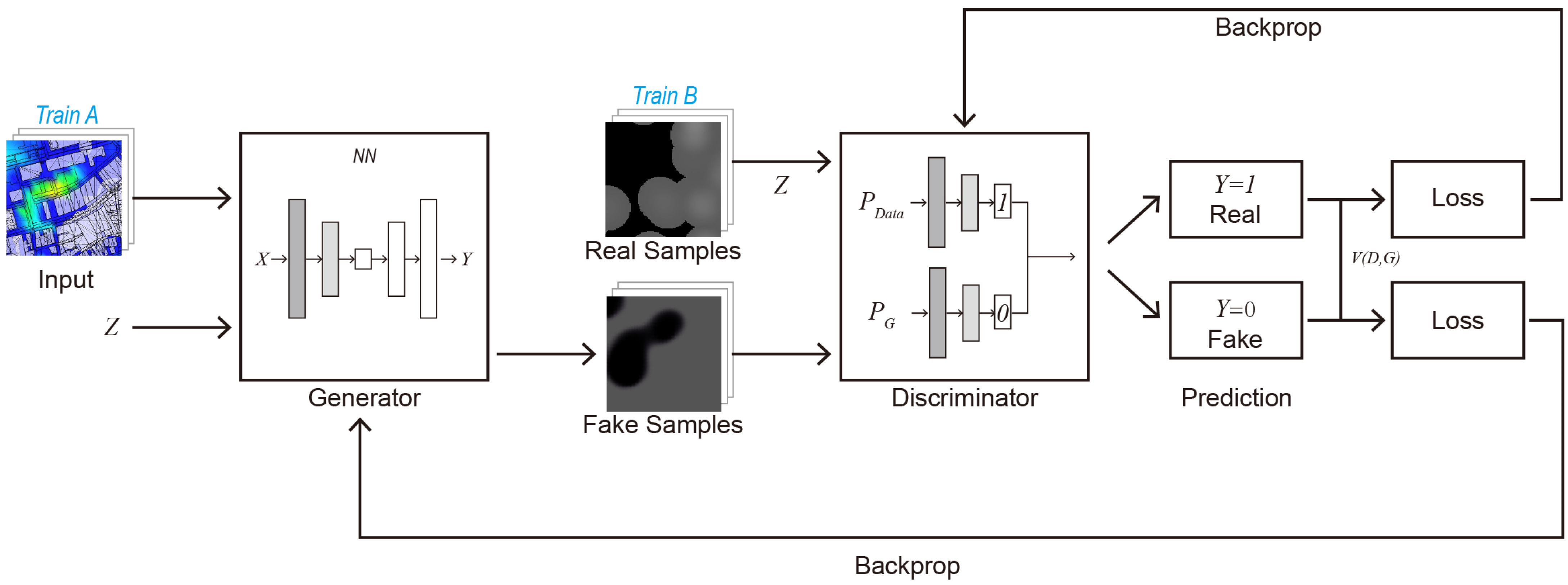


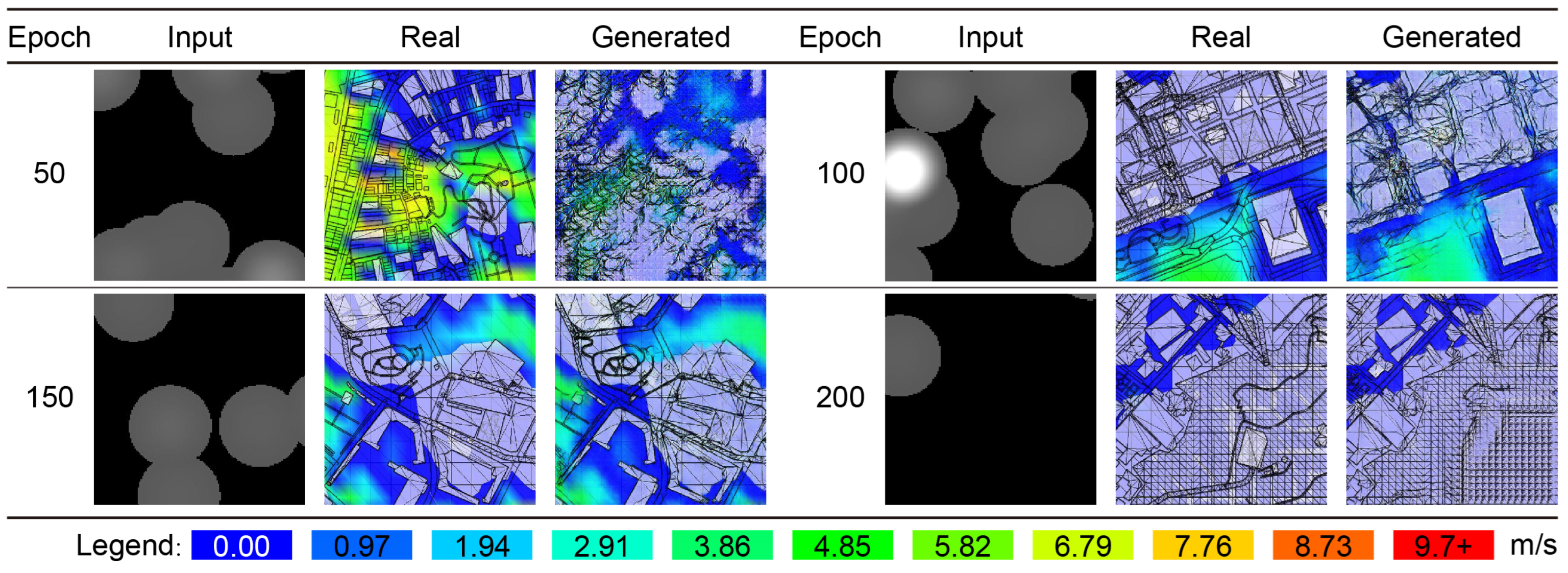


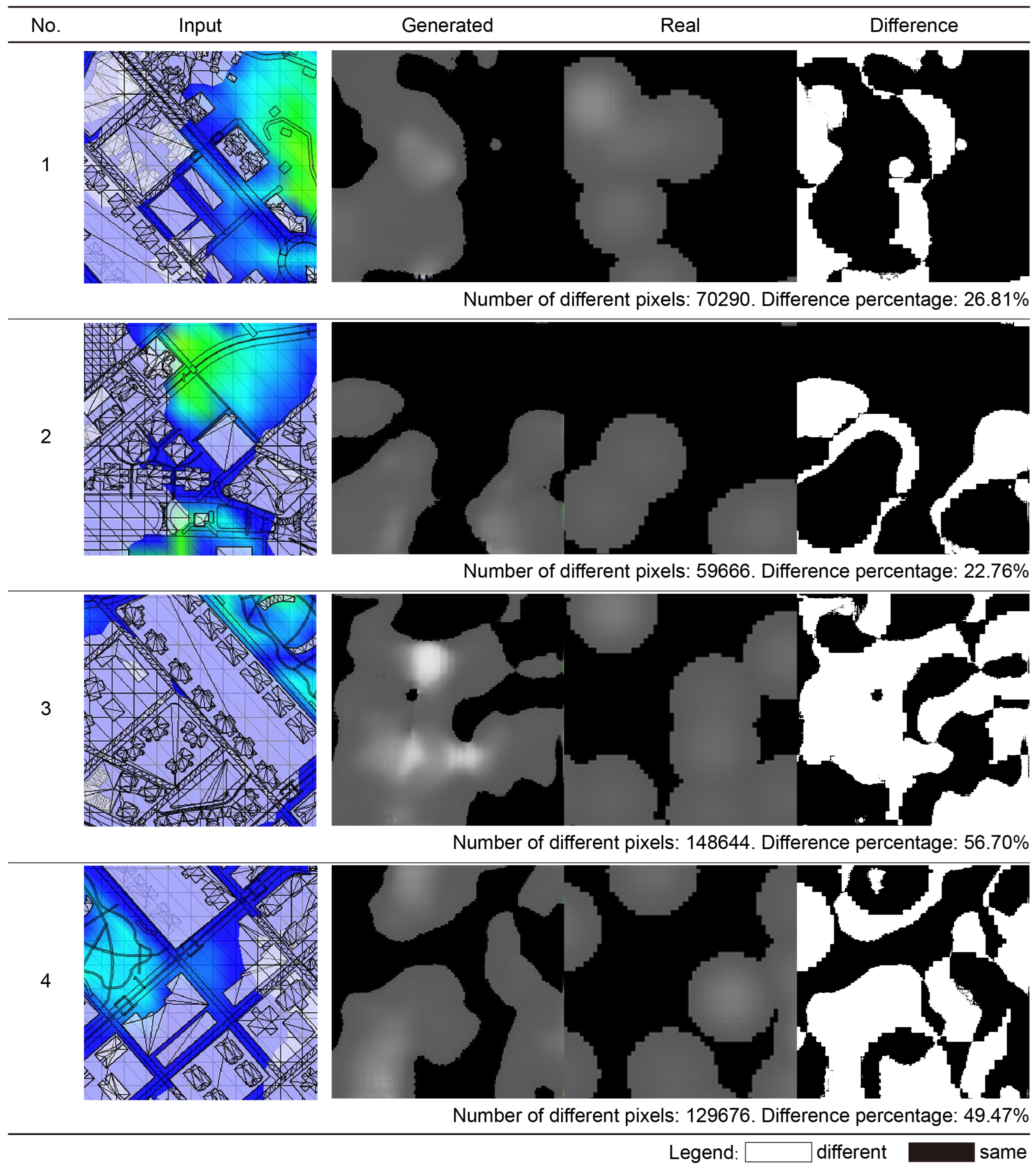
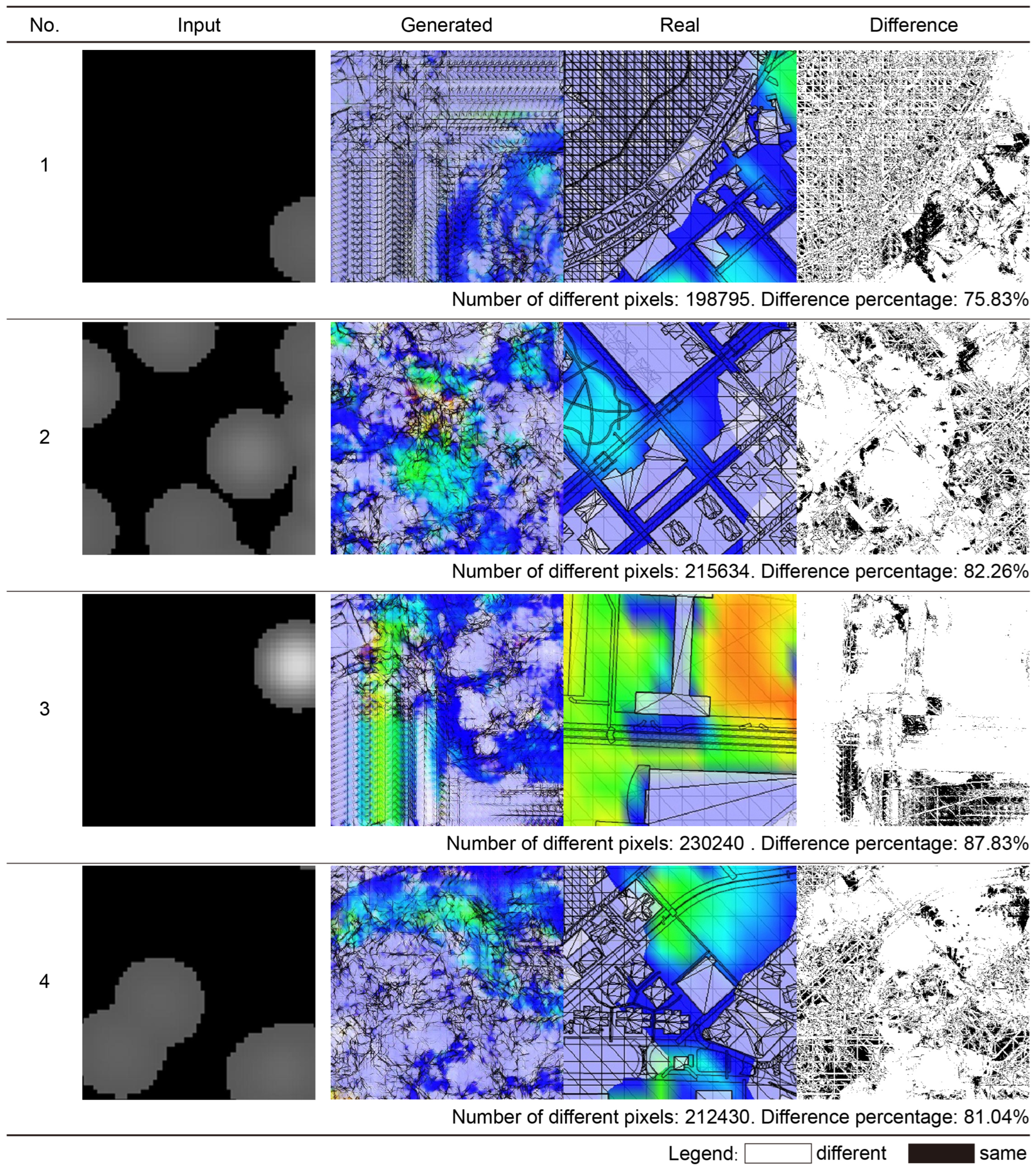
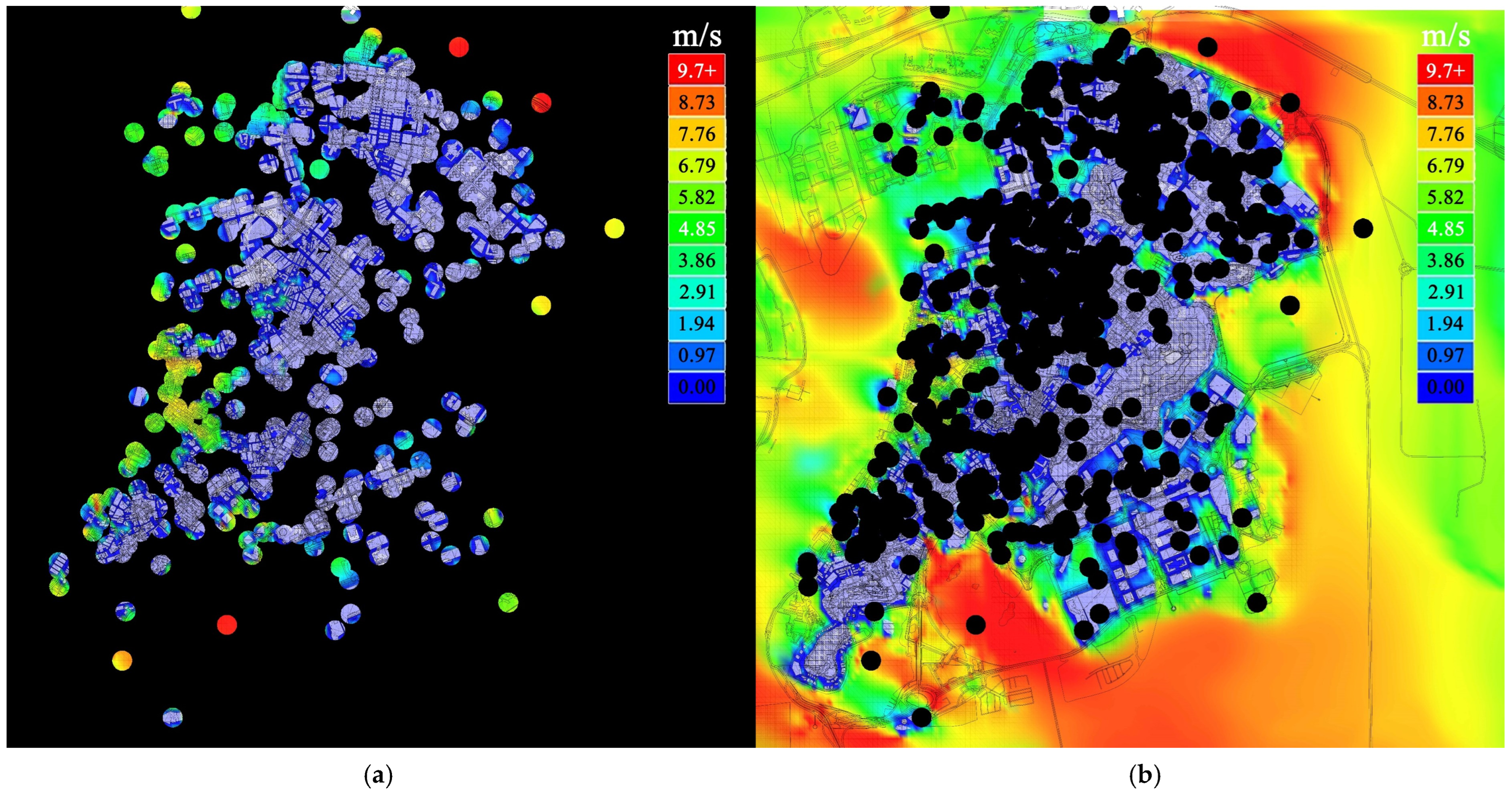


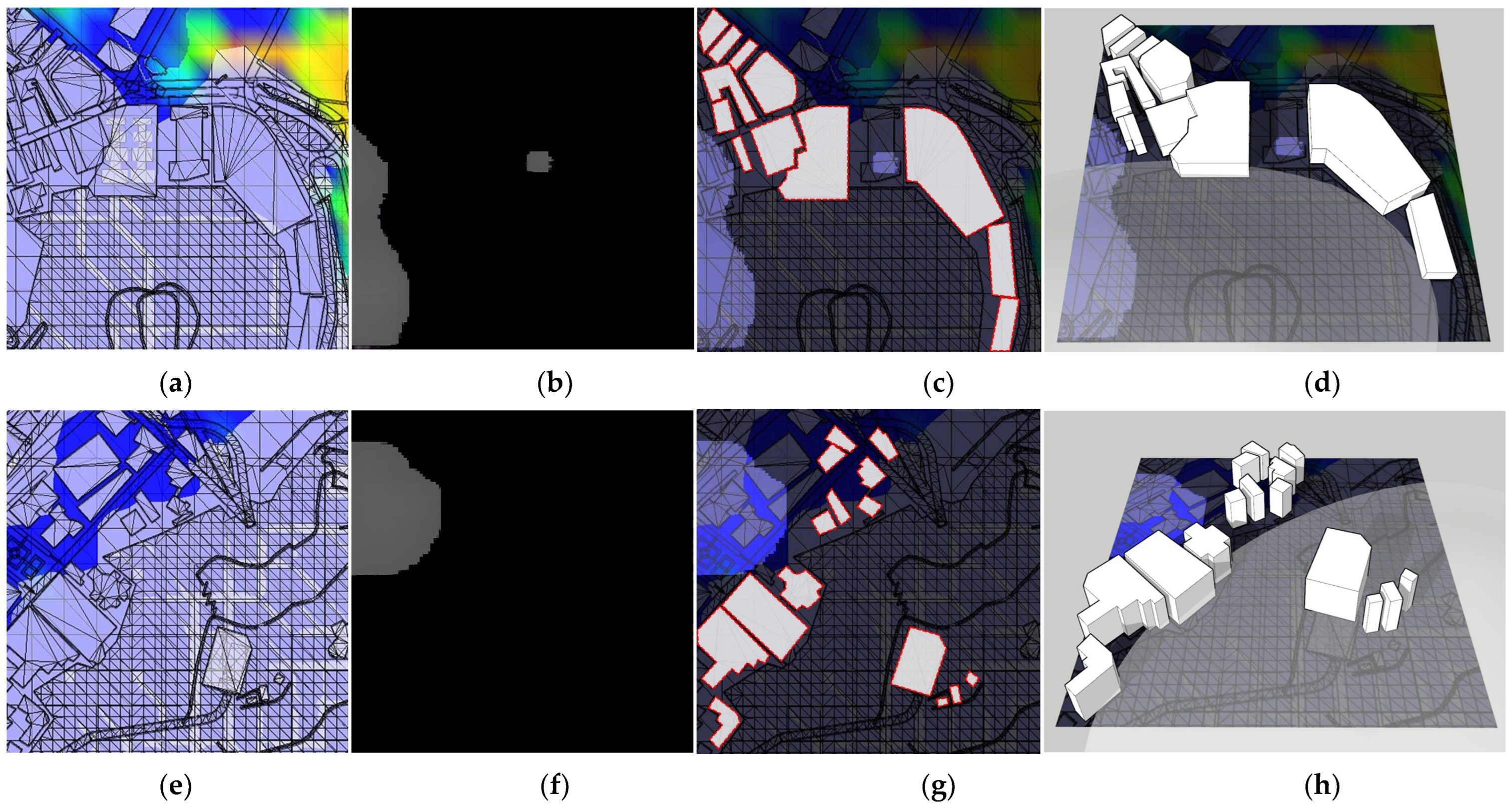

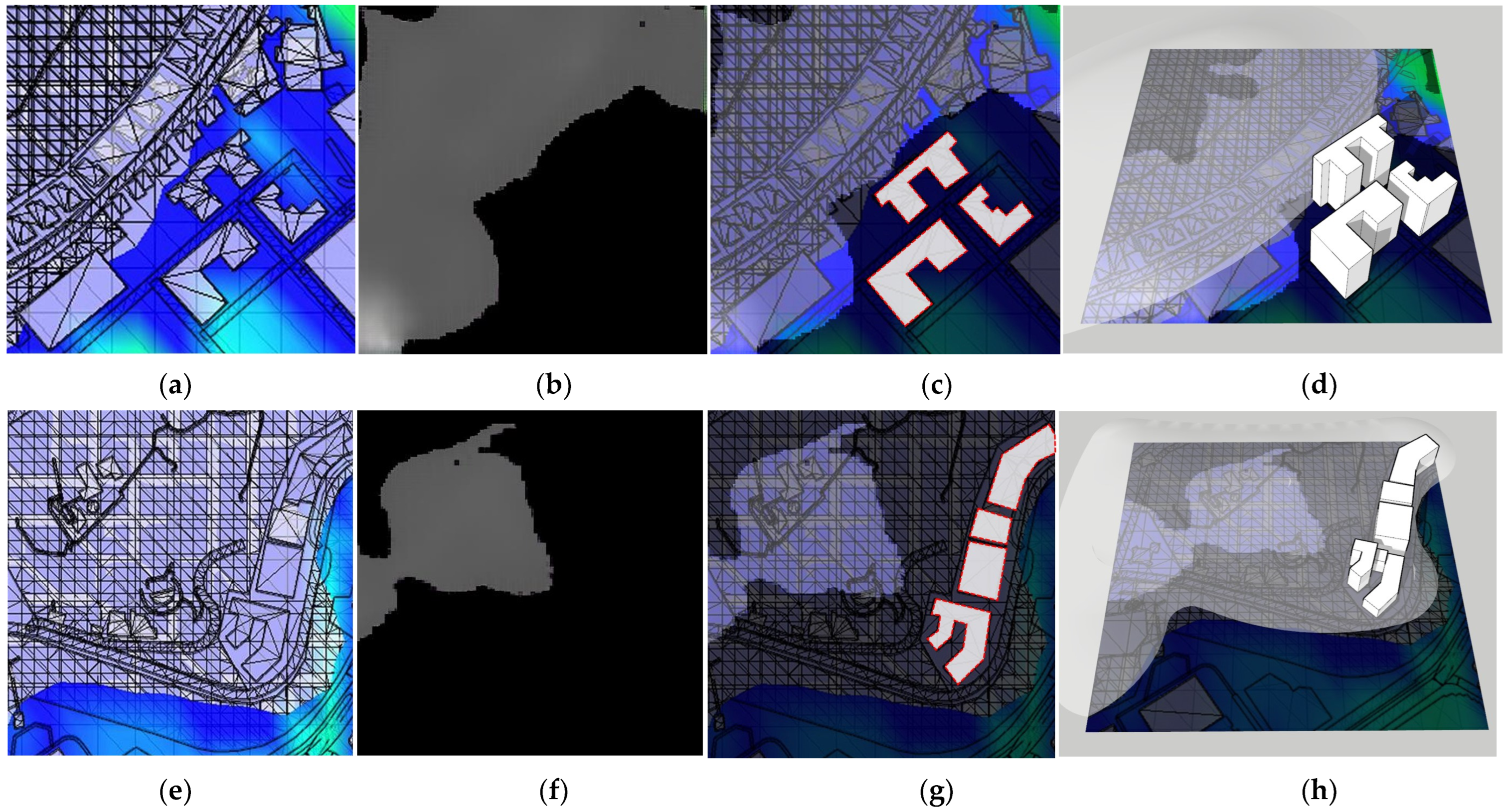
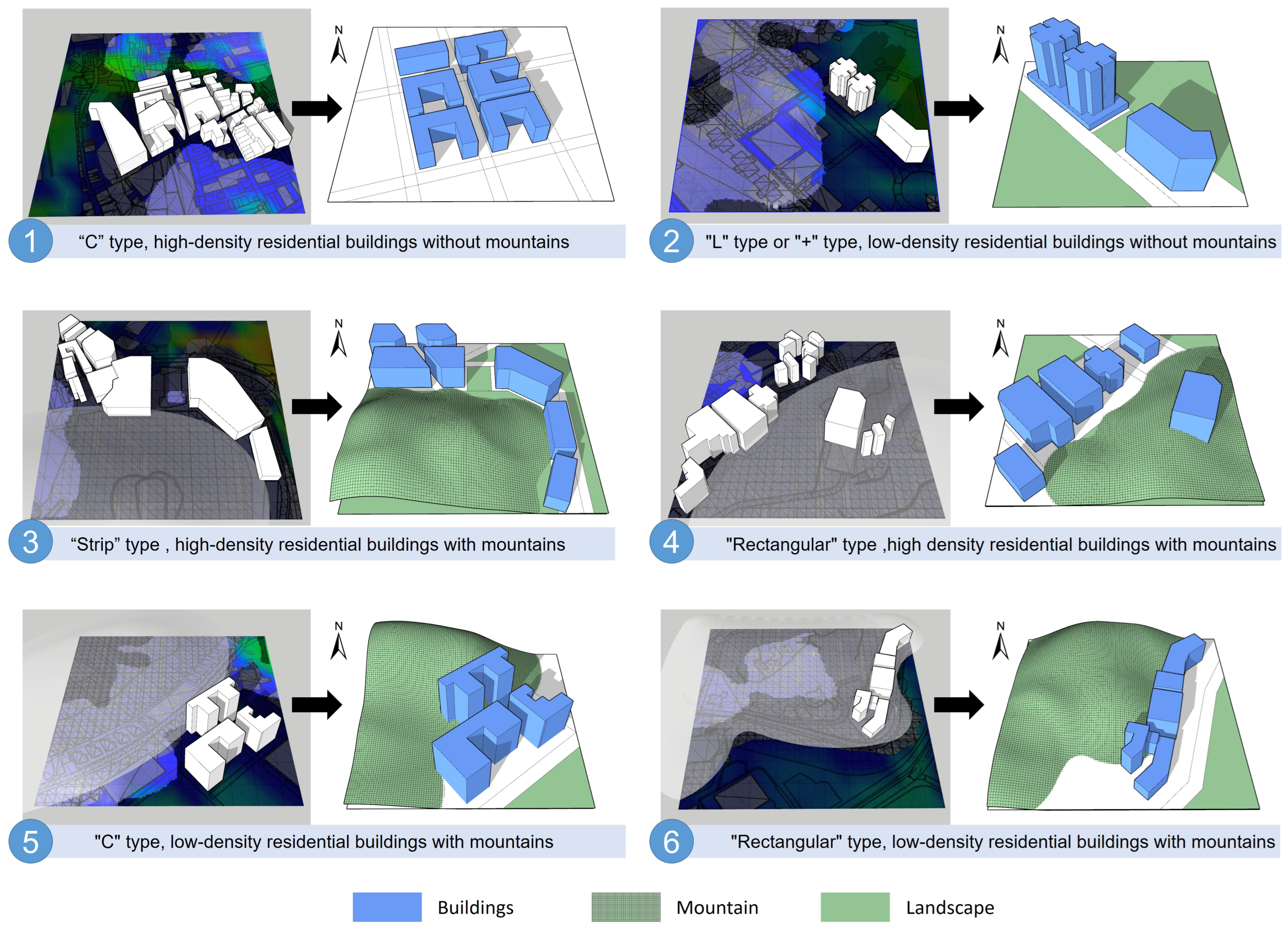
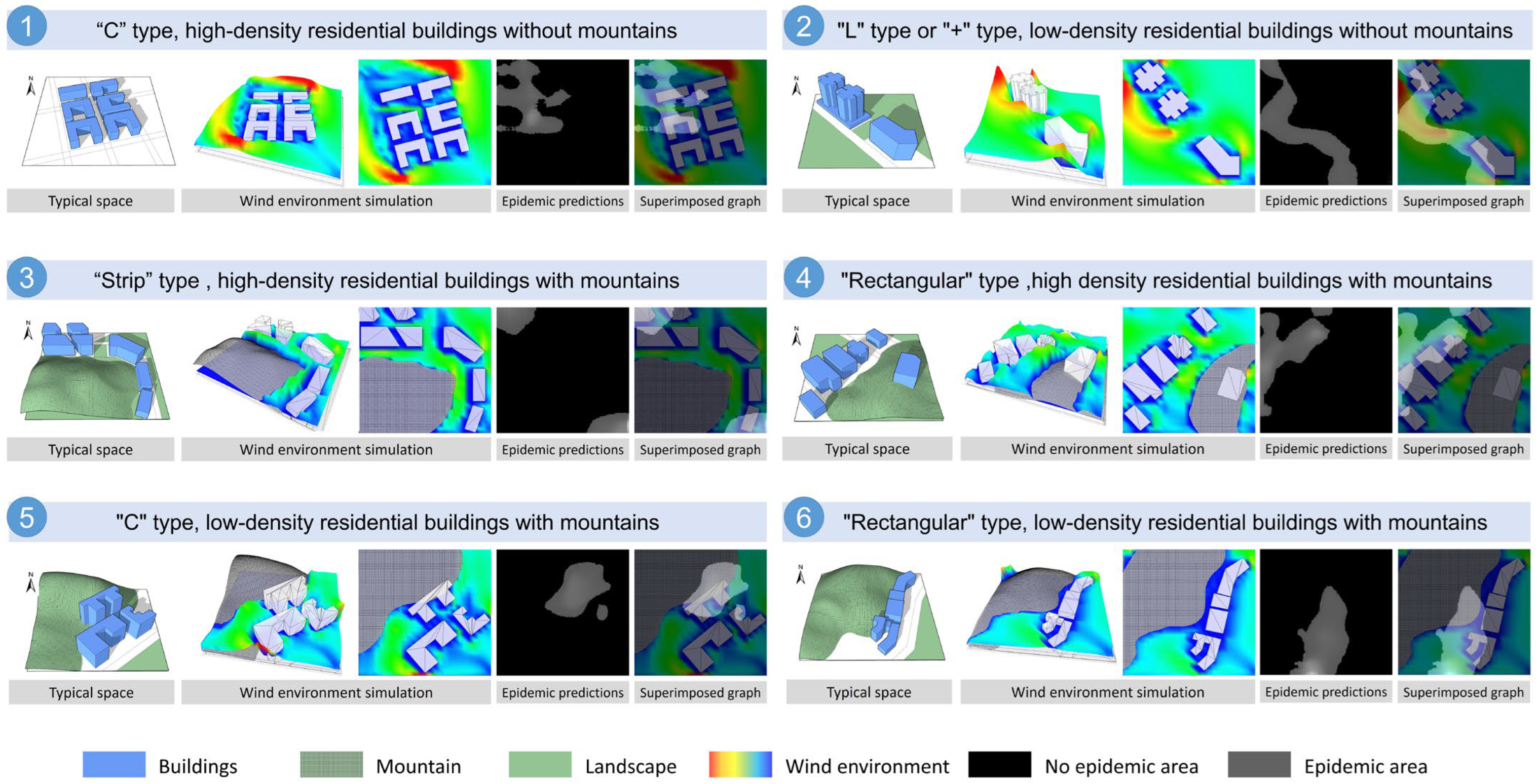
Disclaimer/Publisher’s Note: The statements, opinions and data contained in all publications are solely those of the individual author(s) and contributor(s) and not of MDPI and/or the editor(s). MDPI and/or the editor(s) disclaim responsibility for any injury to people or property resulting from any ideas, methods, instructions or products referred to in the content. |
© 2023 by the authors. Licensee MDPI, Basel, Switzerland. This article is an open access article distributed under the terms and conditions of the Creative Commons Attribution (CC BY) license (https://creativecommons.org/licenses/by/4.0/).
Share and Cite
Zheng, L.; Chen, Y.; Yan, L.; Zheng, J. The Impact of High-Density Urban Wind Environments on the Distribution of COVID-19 Based on Machine Learning: A Case Study of Macau. Buildings 2023, 13, 1711. https://doi.org/10.3390/buildings13071711
Zheng L, Chen Y, Yan L, Zheng J. The Impact of High-Density Urban Wind Environments on the Distribution of COVID-19 Based on Machine Learning: A Case Study of Macau. Buildings. 2023; 13(7):1711. https://doi.org/10.3390/buildings13071711
Chicago/Turabian StyleZheng, Liang, Yile Chen, Lina Yan, and Jianyi Zheng. 2023. "The Impact of High-Density Urban Wind Environments on the Distribution of COVID-19 Based on Machine Learning: A Case Study of Macau" Buildings 13, no. 7: 1711. https://doi.org/10.3390/buildings13071711








